ISO is just the relationship between exposure* and image lightness with the aim of outputting an average 18% grey image.
For me, the ISO setting is irrelevant when setting the exposure* as long as important highlights are not clipped.
I set the smallest f-number that will give my DOF and the slowest shutter speed that will meet my blur requirements without any consideration of ISO at all as long as important highlights are not clipped.
I don't care at all what setting the camera sets ISO to with Auto ISO as long as important highlights are not clipped because I set the final image lightness in post.
* exposure - amount of light striking the sensor per unit area while the shutter is open
** optimal exposure - the maximum exposure* within dof and motion blur requirements without clipping important highlights.
*** under exposed - more exposure* could have been added with the DOF and blur constraints still being met without clipping important highlights.
